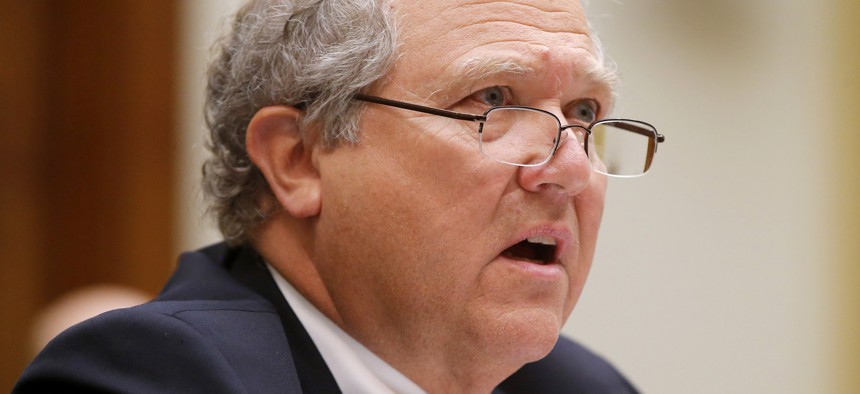
In this June 10, 2014, file photo, John F. Sopko, Special Inspector General for Afghanistan Reconstruction (SIGAR), testifies on Capitol Hill in Washington before the House Foreign Affairs subcommittee on the Middle East and North Africa ASSOCIATED PRESS
It’s Getting Harder to Track US Progress in Afghanistan
Almost every metric “is now classified or nonexistent,” says the special inspector general for Afghan reconstruction.
It’s getting harder and harder for the public to track the U.S. military’s progress in its 17-year war in Afghanistan, the special inspector general for Afghan reconstruction warned Wednesday ahead of the release of his latest quarterly report.
“What we are finding is now almost every indicia, metric for success or failure is now classified or nonexistent. Over time it’s been classified or it’s no longer being collected,” John Sopko told reporters. “The classification in some areas is needless.”
Sopko did not detail what information previously made public would be blacked out in the new report, due out this month. The quarterly reports — which are mandated by Congress and are intended to be public documents — track waste, fraud and abuse in U.S. reconstruction efforts in Afghanistan. The reports have also become an important tracking tool for territorial and population control by the Taliban.
The inspector general reports have long suggested the creeping rise of classification. The number of Afghan security forces killed in action is kept classified at the request of the Afghan government. In the last year, the Defense Department classified basic performance evaluations for the U.S.-backed Afghan security forces, as well as the Afghan Ministry of Interior and Ministry of Defense — metrics that have been used in the past to gauge progress in America’s so-called “forever war.”
In part, the blame rests with the Afghan government, Sopko said. Kabul, which provides some of the information to the U.S. Defense Department, insists that certain data not be made public. (Members of Congress can still view the information in a classified annex.)
“I don’t think it makes sense,” Sopko said. “The Afghan people know which districts are controlled by the Taliban. The Taliban obviously know which districts they control. Our military knows it. Everybody in Afghanistan knows it. The only people who don’t know what’s going on is the people who are paying for all of this and that’s the American taxpayer.”
President Trump in January questioned why the reports are made public, arguing that they provided useful battlefield intelligence to the enemy. “What kind of stuff is this?” he said during a televised cabinet meeting. “The enemy reads those reports; they study every line of it…. I don’t want it to happen anymore, Mr. Secretary. You understand that.” Future investigations, he said, “should be private reports and be locked up.”
Sopko on Wednesday said that the rise in classification was an ongoing trend, not a result of the president’s apparent public order to Acting Defense Secretary Patrick Shanahan. “There’s been some changes” in the latest report, he said, but “I don’t see any direct link” to the January press conference.
“I don’t think there was any link specifically. There’s been no pushback, nothing as a result of that press conference, and I’ve talked to the other IGs about it too,” Sopko said.
Since 2008, the Office of the Special Inspector General for Afghanistan Reconstruction, or SIGAR, has probed the over $100 billion in relief and reconstruction funds spent in Afghanistan since 2002, building the security forces and civil governance institutions, providing development assistance, and running counter-narcotics and anti-corruption efforts. The reports at times have been deeply critical. In November, SIGAR said that Afghan government control over the country was at its lowest point since 2015.
Asked whether the U.S. is meeting its strategic goals in Afghanistan, Sopko was blunt.
“Ultimately, I don’t think we’ve met all our strategic goals there. The two major goals were, we were going to kick the terrorists out and create a government that could keep the terrorists out. Obviously we haven’t kicked the terrorists out if they’re still blowing things up and we’re negotiating with them,” Sopko said. “That strategic goal is now changed to get them to the peace negotiations. So maybe ultimately, we will ultimately achieve that strategic goal.
“I don’t know.”




